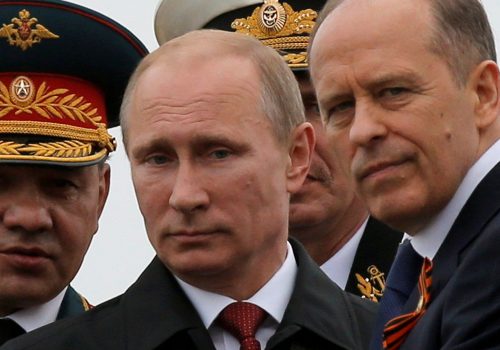Defending the United States against Russian dark money
Executive summary
Warfare evolves. For too long, the focus has been on military, especially nuclear, security, while twenty-first-century conflict is increasingly becoming “hybrid,” involving cyber, finance, and many other elements that elude traditional deliberative government policy processes and the regulations housed within them. Financial controls still focus on terrorist financing, even as the US National Security Strategy of December 2017 identified China and Russia as key challenges, revisionist powers “that use technology, propaganda, and coercion to shape a world antithetical to our interests and values.”1“A New National Security Strategy for a New Era.” The White House. The United States Government, December 19, 2017. https://www.whitehouse.gov/articles/new-national-security-strategy-new-era/. All these challenges involve dark money—financing that is not publicly visible. It may be illicit or just legally undefined. This paper focuses on Russian money laundering to demonstrate the scope of the challenge and illustrate how combatting the abuse of US jurisdiction is a key element of domestic security, not only foreign policy. The US financial system is an equal opportunity target for illicit actors, but Russia poses the greatest proven threat and the Russia paradigm is the most familiar to the paper’s authors, and perhaps also its audience.2The national security risk is by no means limited to Russia. The framework we propose could apply to China, Iran, North Korea, or Venezuela, or any third party jurisdiction that seeks to exploit weaknesses in USUS financial regulation for purposes of political influence or criminal activity.
According to the most reliable estimates, Russia has the world’s largest volume of dark money hidden abroad—about $1 trillion—both in absolute terms and as a percentage of its national GDP.3Filip Novokmet, Thomas Piketty, and Gabriel Zucman, From Soviets to Oligarchs: Inequality and Property in Russia, 1905-2016. NBER Working Paper no. 23712. Cambridge, MA: National Bureau of Economic Research, August 2017. An estimated one-quarter of this amount is controlled by Russian President Vladimir Putin and his close associates, and the Kremlin appears to be able to persuade dependent oligarchs to assist financially in its foreign policy undertakings.4Anders Åslund, Russia’s Crony Capitalism: The Path from Market Economy to Kleptocracy, Yale University Press, 2019, p. 174. These oligarchs hire the best lawyers, auditors, bankers, and lobbyists in the world to develop legal means to conceal and launder their funds. They thus often have greater resources than the regulators tasked with maintaining the integrity of national financial systems. And while governments generally operate in their own single country, a serious Russian oligarch lives (with eminent security) in half a dozen countries, has layers of anonymous shell companies in a score of offshore jurisdictions, and his funds move at lightning speed between them.
We argue that these funds pose a serious national security threat to the United States because this money can be exploited and steered by the Kremlin for espionage, terrorism, industrial espionage, bribery, political manipulation, disinformation, and many other nefarious purposes. For Russia, prominent analysts have observed, corruption has been transformed into an instrument of national strategy.5Philip Zelikow, Eric Edelman, Kristofer Harrison and Celeste Ward Gventer, “The Rise of Strategic Corruption: How States Weaponize Graft,” Foreign Affairs, July/August 2020, pp. 107-120. Russia, and not China, played a major role in the US elections in 2016, according to both the Report on the Investigation into Russian Interference in the 2016 Presidential Election, popularly known as the Mueller report, and the Report of the Select Committee on Intelligence United States Senate on Russian Active Measures Campaigns and Interference in the 2016 U.S. Election.6US Department of Justice, Special Counsel Robert S. Mueller, III, “Report on the Investigation into Russian Interference in the 2016 Presidential Election, [Mueller Report]; Report of the US Senate Select Committee on Intelligence on Russian Active Measures Campaigns and Interference in the 2016 US Election.
In Part I of this paper, we examine the pervasiveness of Russian money laundering practices globally, why the money is laundered, methods, and jurisdictions used, and how these exploit weaknesses in the US system. We provide concrete examples, drawing on recent investigations, of how opaque financial structures allow known Russian actors who have worked against the interests of the United States to operate well within its borders.
Part II of the paper discusses how to reframe anti-money laundering and counterterrorism finance (AML/CFT) strategy to focus not only on foreign policy threats emanating from abroad, but on domestic preventive measures and combating risks at home. Using Russia as a case in point, we provide recommendations tailored to the money laundering typologies used by its illicit actors and their financial intermediaries. The United States and likeminded partners should apply four basic principles:
- Transparency. Timely and efficient access to beneficial ownership information is long overdue in the United States; regulation must cover ultimate beneficiaries of a wide range of obliged entities, from formal financial institutions to intermediaries such as lawyers and brokers to purveyors of valuable assets such as real estate brokers and art dealers. The European Union (EU) has imposed a legal requirement to submit information on ultimate beneficial ownership. Regulators must use this information not only as a preventive measure but for rigorous investigation and enforcement.
- Swift reporting of relevant transactions. Financial reporting can be slow and spam financial intelligence units with irrelevant and minor transactions, while cooperation between financial intelligence units is cumbersome and falls far behind the speed of commerce. Likeminded financial authorities should develop a greater joint understanding of the typologies of illicit financial movements and develop swift and more selective reporting keyed to criteria to uncover corruption. Likeminded countries with close intelligence relationships should incorporate financial threats into the security dialogue.
- International cooperation among stronger regulators. Despite having different vulnerabilities within their respective systems, the United States and the EU face similar threats. The EU’s AML/CFT reform proposal to establish an EU-wide regulator to supervise national competent authorities in the member states and have credible enforcement capabilities should receive widespread support from the United States. Conversely, the United States needs to revamp and strengthen the Financial Crimes Enforcement Network (FinCEN) in the Department of the Treasury.
- Credible fines. In recent years, US fines for money laundering have dwindled to the point that, unlike penalties for sanctions evaders, they no longer serve as a credible threat for money launderers. And only in rare circumstances have European authorities charged significant fines for money laundering. European Banks should establish proper compliance departments, as exist in the United States, and boost the fines they impose.
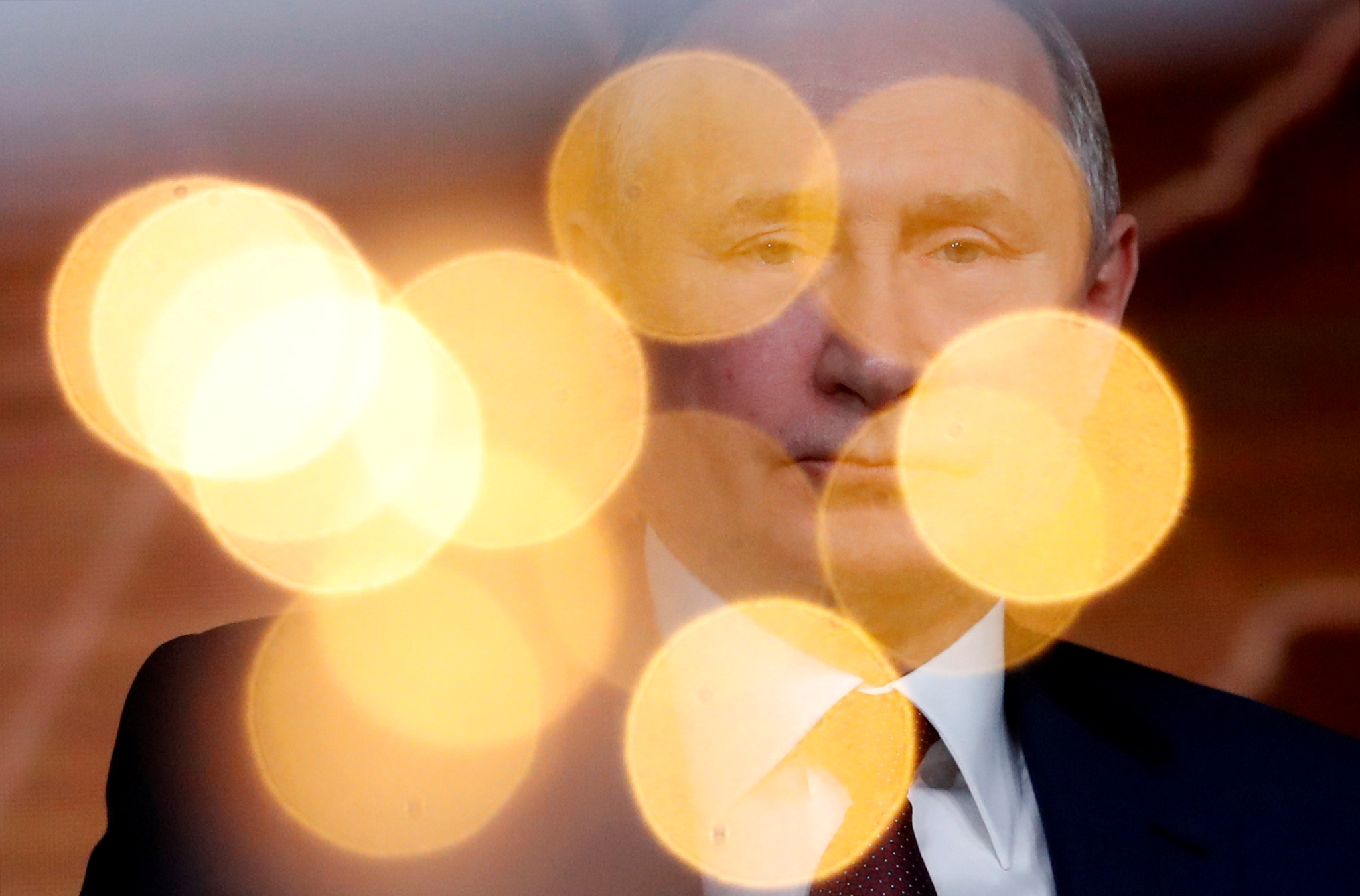
Vladimir Putin in Moscow, Russia, on December 19, 2019. About one-quarter of Russia’s dark money hidden abroad is controlled by Russian President Vladimir Putin and his close associates. REUTERS/Evgenia Novozhenina
Introduction
The Mueller report demonstrates how Russian offshore finance and oligarchs were deployed by the Kremlin to interfere in and after the 2016 US election. The generation and spread of nontransparent Russian wealth demonstrates that the United States and its European partners need to strengthen their defenses against illicit finance as a national security priority. The United States must reckon with a full-on threat of imported Russian-style kleptocracy: illicit financial risk goes hand in hand with watered-down campaign finance restrictions and poor enforcement of the Foreign Agents Registration Act (FARA). The United States needs to reframe its view of money laundering as a national security threat. Such a policy shift may be the only way to prevent kleptocratic behavior from undermining even the world’s most transparent economies.
As a legacy of the post-9/11 boom in AML/CFT regulation, counterterrorism finance became a well-oiled machine well integrated into the national security framework, such as the US government’s National Counterterrorism Center, where foreign and domestic equities can comfortably comingle. Some illicit financial threats have immediate tragic implications if they are overlooked, as the financing of 9/11 and countless other terrorist attacks globally have proven. Today’s challenge is more incremental and can only be addressed over time: to disentangle the web of illicit actors and their intermediaries who slowly work to undermine the probity of Western financial institutions, corporate practices, and the political systems that rely on them. The national security focus on foreign financial behavior has allowed US sanctions policy to police other countries’ ills, but the spirit of the Global Magnitsky Act of December 2016 is only truly global if we also turn the magnifying glass on ourselves.
As the recently leaked “FinCEN Files”7Jeremy Singer-Vine, et al.“The FinCEN Files By The (Very Big) Numbers.” BuzzFeed News, September 24, 2020. https://www.buzzfeednews.com/article/jsvine/fincen-files-explainer-data-money-transactions. have shown, internal reforms are needed in the United States. FinCEN may receive potentially strong leads from commercial banks but be unable to determine whether they contain a viable lead for investigation. Additional resources; improved personnel recruitment, such as direct hiring authority for specialists; and better organizational design will each contribute to more effective analysis and deployment of financial information to combat financial crime. The advance notice of proposed rulemaking (ANPRM) on Anti-Money Laundering Program Effectiveness8“Anti-Money Laundering Program Effectiveness.” Federal Register, September 17, 2020. https://www.federalregister.gov/documents/2020/09/17/2020-20527/anti-money-laundering-program-effectiveness. (some elements of which are discussed later in this paper) issued in September and the final ruling on non-federally supervised banking institutions, or the “Gap Rule,”9“Financial Crimes Enforcement Network; Customer Identification Programs, Anti-Money Laundering Programs, and Beneficial Ownership Requirements for Banks Lacking a Federal Functional Regulator .” Federal Register 85, no. 179 (September 15, 2020): 57129–38. https://www.govinfo.gov/content/pkg/FR-2020-09-15/pdf/2020-20325.pdf. expand regulatory scrutiny of financial institutions and intermediaries, and are unequivocal regulatory steps forward. Above all, however, FinCEN needs high-level policy direction to accelerate this trajectory. The challenge of illicit finance remains an issue of priority setting. US intelligence, regulatory, law enforcement, and judicial authorities are incredibly powerful when given a clear mandate. The USA PATRIOT Act and ensuing counterterrorism efforts have proven this by cleaning up the global shell banks of terrorist financing. But now the United States and, most importantly, its judiciary and law enforcement must consider the abuse of the US financial system not only in terms of discreet acts and actors or as a conduit to fund misdeeds abroad, but as an essential component of protecting the United States’ most basic democratic functions.
I. How illicit Russian money comes to the United States and the dangers it poses
The Central Bank of the Russian Federation (CBR) still maintains excellent summary public statistics on Russia’s international transactions online, showing a steady and large current account surplus accompanied by a sizeable capital outflow.10This section draws on Anders Åslund, Russia’s Crony Capitalism: The Path from market Economy to Kleptocracy, Yale University Press, 2019, pp. 154-179. Since 1989, Russia has seen steady and large net capital outflows, even though the Russian government made the ruble fully convertible and liberalized financial markets in July 2006, indicating that the movement of financial assets has not been above board.
Assessments of the Russian offshore holdings vary. James S. Henry of Columbia University assessed for the Tax Justice Network that by the end of 2014 no less than $1.3 trillion of Russian assets were sitting offshore.11Heather Stewart, “Offshore Finance: More than $12tn siphoned out of Emerging Economies,” The Guardian, May 8, 2016. But this number appears too high, presumably because it includes outflows that returned to Russia.12Gabriel Zucman, The Hidden Wealth of Nations: The Scourge of Tax Havens, University of Chicago Press, 2015. Filip Novokmet, Thomas Piketty, and Gabriel Zucman have analyzed Russian offshore wealth to analyze inequality, offering a very different perspective on the same facts. They argue that Russia is the country in the world where offshore wealth is most significant “at about $800 billion or 75 percent of national income in 2015.” One can reasonably estimate a figure of $920 billion of net private Russian offshore wealth at the end of 2019.13Filip Novokmet, Thomas Piketty, and Gabriel Zucman. 2017. From Soviets to Oligarchs: Inequality and Property in Russia, 1905-2016. NBER Working Paper no. 23712. Cambridge, MA: National Bureau of Economic Research, August, pp. 8, 21, 23. All this offshore wealth is private. It does not include the international currency and gold.
Traditionally, illicit Russian money has left the country through Cyprus because of the favorable double-taxation agreement dating back to Soviet times. Russian foreign direct investment in Cyprus amounted to $36 billion or 150 percent of its GDP in 2013, but $22 billion pertained to “special purpose enterprises,” which were only registered in Cyprus but invested elsewhere. In the aftermath of the banking crisis in 2013, however, the International Monetary Fund (IMF) required Cyprus to eliminate shell companies as a condition of its bailout.14IMF (International Monetary Fund). Cyprus: Fifth, Sixth, and Seventh Reviews under the Extended Arrangement under the Extended Fund Facility, June 4, 2015, p. 20, GDP values in current USD from IMF (International Monetary Fund). IMF World Economic Outlook database, April, 2018. Since then, the country has begun to clean up its act and closed tens of thousands of Russian bank accounts.
These funds typically proceeded to the British Virgin Islands and then to the Cayman Islands, but there are many alternative tracks. In each jurisdiction, half a dozen shell companies are layered on top of one another to conceal the riskiest assets. As money launderers have grown more sophisticated, dirty money has begun transiting through many jurisdictions with a large number of banks. Money launderers tend to transit their assets through a number of jurisdictions as their money is being laundered, as evidenced by “Russian laundromats” in Moldova, Latvia, Estonia, and Lithuania.15Organized Crime and Corruption Reporting Project (OCCRP). 2017. The Russian Laundromat Exposed, March 20. Organized Crime and Corruption Reporting Project. The Organized Crime and Corruption Reporting Project broke the story about the “Russian Laundromat” in 2014, and, together with reporters from the eminent independent Russian newspaper Novaya Gazeta, detailed how nineteen Russian banks laundered $20.8 billion to five thousand one hundred and forty companies with accounts at seven hundred and thirty-two banks in ninety-six countries from January 2011 to October 2014.16Organized Crime and Corruption Reporting Project (OCCRP), The Russian Laundromat Exposed, March 20, 2017.
Yet, the laundered funds do not stop in offshore havens that lack financial depth and access to global financial markets. Few jurisdictions with strong rule of law accept large amounts of dirty money, but the United States offers a ripe environment for offshore funds and is a hub for global money laundering. In the end, the money often moves from the Cayman Islands to the United States—mainly through the state of Delaware—and the United Kingdom. These are the two countries that have the deepest financial markets in the world and accept anonymous companies. The Cayman Islands is a tiny British overseas territory with sixty thousand inhabitants but one hundred and fifty-eight banks. The US Treasury publishes annual reports of foreign investments in US securities. In its 2019 report, the Treasury stated that Cayman Islands was the second biggest investor in US securities, before the United Kingdom but after Japan, with $1.87 trillion of investment in US securities, of which $1.08 trillion was in equities on June 30, 2018.17“Report on Foreign Portfolio Holdings of U.S. Securities at End-June 2019.” U.S. Department of the Treasury, April 30, 2020. https://home.treasury.gov/news/press-releases/sm994.
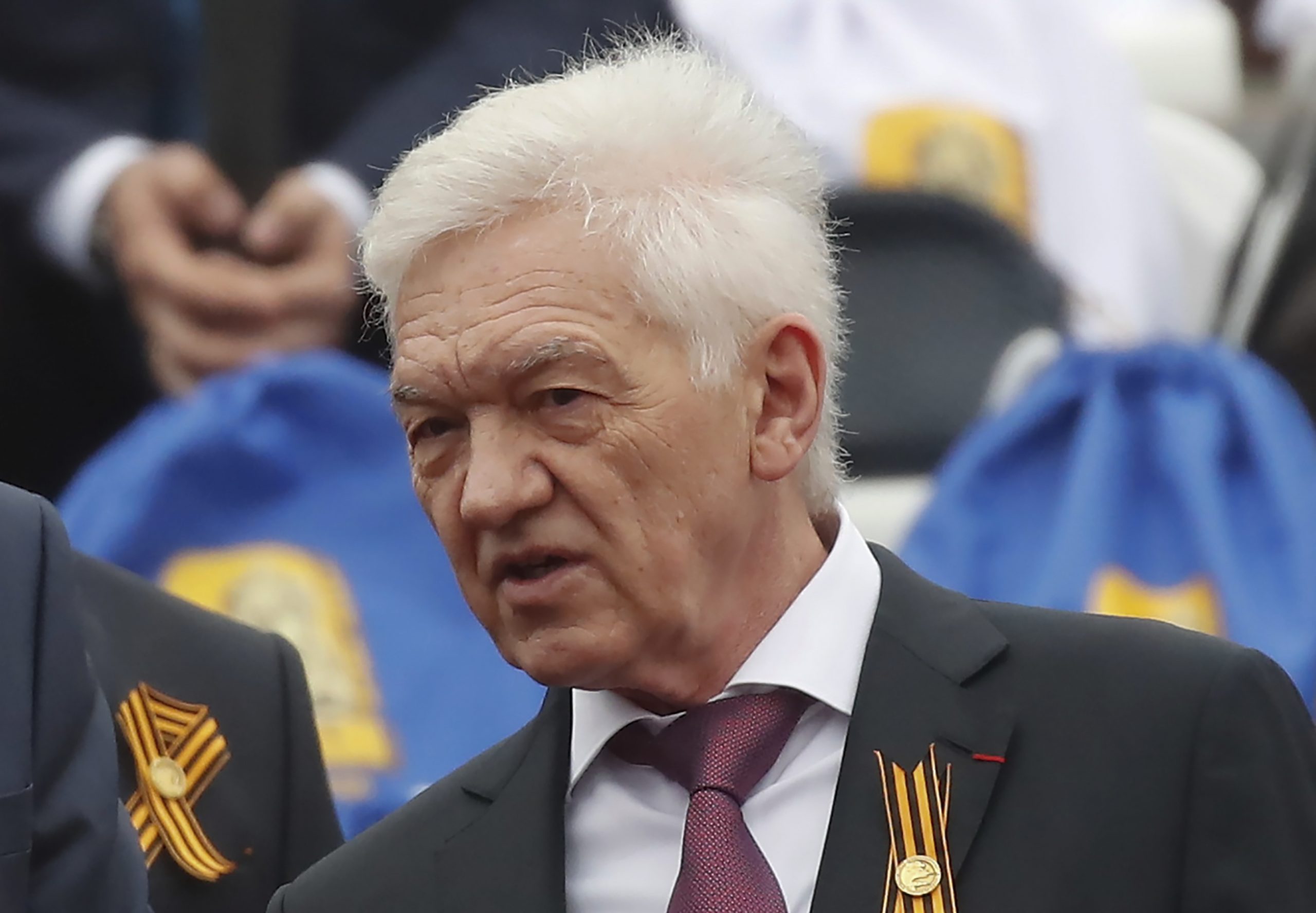
Russian tycoon Gennady Timchenko attends the Victory Day parade, which marks the anniversary of the victory over Nazi Germany in World War Two, in Red Square in central Moscow, Russia May 9, 2019. REUTERS/Maxim Shemetov
Why is Russian offshore money so often illicit?
In 2004, Putin consolidated his political power and soon afterward his control over much of the economy, putting an end to an era of wild west capitalism that characterized the 1990s. Putin allows a few friends to tap the financial resources of state companies and the state itself.18Anders Åslund, Russia’s Crony Capitalism: The Path from Market Economy to Kleptocracy, Yale University Press, 2019. He appointed close associates as chief executives, primarily of Gazprom, Rosneft, and the armaments industry, who tap these companies for their own gain. Putin and his friends have made fortunes through privileged public procurement at inflated prices and asset stripping privileged trading, forgiven state bank loans, and stock manipulation. An additional form of enrichment is racketeering, the extent of which is difficult to establish, but Russian law enforcement agencies and state companies indulge in corporate raiding, taking over well-run private companies without sufficient protection or extorting tributes from them.19Boris Nemtsov and Vladimir Milov, “Putin i Gazprom (Putin and Gazprom),” Novaya Gazeta, Moscow, 2008. Boris Nemtsov and Vladimir Milov. 2010a. “Putin: What 10 Years of Putin Have Brought,” Novaya Gazeta, Moscow, 2010a. Boris Nemtsov and Vladimir Milov, “Putin: Korruptsiya 2, (Putin Corruption 2),” Novaya Gazeta, Moscow, 2010. Opposition activists, the late Boris Nemtsov and Vladimir Milov, assessed the market value of the assets that Gazprom transferred to Putin’s cronies between 2004 and 2007 at a stunning $60 billion.20Aslund, Russia’s Crony Capitalism, 32-3. From 2011 to 2019, the official Gazprom capital expenditures amounted to $295 billion or an average of $33 billion a year.21Gazprom.ru In line with the Nemtsov-Milov findings, we would presume that one-third of these funds were overpayments amounting to excessive profits of brothers Arkady and Boris Rotenberg, and Gennady Timchenko, all billionaires. These funds have in all probability been transferred to offshore havens.22Bastian Obermayer and Frederik Obermaier, The Panama Papers: Breaking the Story of How the Rich & Powerful Hide Their Money, London: Oneworld, 2016.
Asset stripping is not a one-way street. It can be repeated. State companies tend to sell and buy the same companies, such as Gazprombank and Sogaz, Russia’s dominant insurance company, repeatedly, selling them at a low price to favored buyers, and purchasing them back from the same people at a much higher price. These multiple transactions render it difficult to keep up with current ownership. The key players in this game are three old friends and Putin’s longstanding business partners from St. Petersburg—Timchenko, Arkady Rotenberg, and Yuri Kovalchuk. Timchenko made his fortune as an oil trader, at the independent gas producer Novatek, by stripping Russia’s largest petrochemical company Sibur from Gazprom, and by building gas pipelines for Gazprom.23Catherine Belton, Putin’s people: How the KGB Took Back Russia and then Took on the West, New York: Farrar, Straus and Giroux, 2020, p. 377. Arkady Rotenberg is one of Putin’s earliest friends. They did judo together as teenagers. In 2008, Rotenberg struck gold when Gazprom sold him five construction subsidiaries for a pittance, allowing him to form his company Stroygazmontazh, Gazprom’s biggest contractor, to build gas pipelines. And Yuri Kovalchuk has served as the chief executive of Bank Rossiya since 1991, but his real role is much bigger. He has acquired large financial and media assets from Gazprom, and he manages the financial flows of the whole Putin group as well as some twenty Russian television channels.24Åslund, Russia’s Crony Capitalism, 132-146.
As Russia has grown more kleptocratic and authoritarian, another form of elite enrichment has become increasingly important, namely extortion by the Kremlin of the truly rich. US businessman and now Putin opponent Bill Browder argues that after Mikhail Khodorkovsky’s conviction in 2005, Putin demanded 50 percent of the wealth of the other oligarchs. “He wasn’t saying 50 percent for the Russian government or the presidential administration, but 50 percent for Vladimir Putin personally. From that moment on, Putin became the biggest oligarch in Russia and the richest man in the world,” Browder testified before the US Senate Judiciary Committee in 2017.25Bill Browder, “Testimony to the Senate Judiciary Committee,” The Atlantic, July 25, 2017. This is possible, though not proven. What we do know from many interviews is that Kremlin extortion is standard procedure and that tens of millions of dollars are customarily extorted in “donations” for “charity” from individual oligarchs.
In June 2013, the retiring longtime chairman of the CBR, Sergei Ignatiev, made a remarkable statement to the State Duma. He declared that the CBR had revealed one network of fly-by-night firms that had illegally transferred at least $25 billion out of Russia in violation of currency and tax laws between 2010 and 2012. Ignatiev stated: “I have the impression that this whole net of one-day firms is controlled by one group of people.”26Tat’yana Voronova and Aleksei Nikol’sky, “Posledny akkord Ignatieva (Ignatiev’s Last Accord),” Vedomosti, June 20, 2013. That day, the CBR posted a memorandum on its website claiming that about $15 billion had been transferred illegally through Belarus and $10 billion through Kazakhstan through fictitious import invoices in 2012.27Nataliya Biyanova, “TsB: 40% ottoka kapitala iz Rossii obespechil Tamozhenny soyuz (CB: The Customs Union Facilitated 40% of the Capital Outflow from Russia)”, Vedomosti, June 20, 2013. This is $25 billion in one year. No public explanation was ever given.
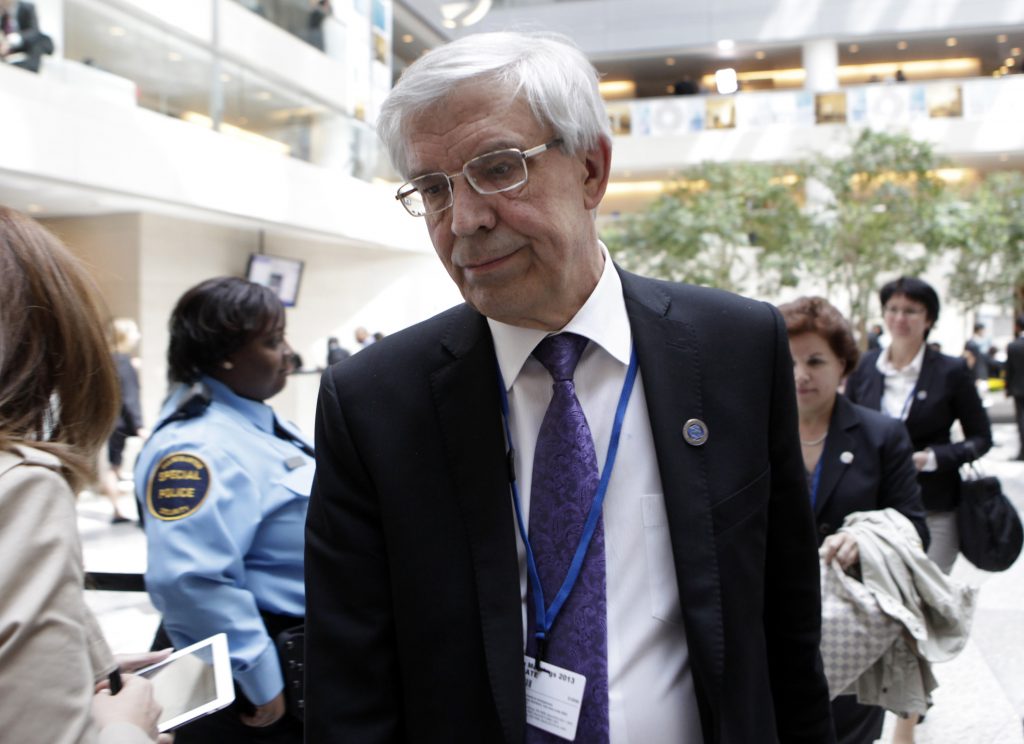
I have the impression that this whole net of one-day firms is controlled by one group of people.”
Central Bank of Russia Chairman Sergei Ignatiev leaves after the International Monetary and Financial Committee (IMFC) meeting during the Spring Meeting of the IMF and World Bank in Washington, April 20, 2013. REUTERS/Yuri Gripas
Recently, after recovering from being poisoned with the nerve agent Novichok and a three-week coma, Russian opposition leader Alexei Navalny told the German magazine Der Spiegel: “The best approach is to protect your own people and society from Russia’s criminal money. What Putin cares about is power and personal enrichment, and the two are inseparably linked. How many billions can he give to his daughters, his friends? It would hurt them if Europe were to finally set limits, confiscate their assets and no longer allow them to travel. Despite all the sanctions imposed so far, things are still quite comfortable for these people in the West. Nothing will change as long as the Russian elite can use Europe’s infrastructure.”28Alexei Navalny on His Poisoning: “I Assert that Putin Was Behind the Crime,” Dear Spiegel, October 2, 2010. Navalny’s statement is key to understanding why Russian abuse of Western financial jurisdiction is a foreign policy and national security concern.
Why are Russian offshore funds a risk for the United States?
Anonymous foreign funds are risky for many reasons.29Philip Zelikow, Eric Edelman, Kristofer Harrison and Celeste Ward Gventer, “The Rise of Strategic Corruption: How States Weaponize Graft,” Foreign Affairs, July/August 2020, pp. 107-120. They can be used for espionage, industrial espionage, terrorism, drug trade, human trafficking, illicit arms trade, sanctions evasion, bribery, disinformation, political interference, money laundering, or simply tax evasion. Usually, several crimes go together, but without a clear, demonstrable link between a financial asset and a criminal act, it is difficult for authorities to target them. Why exactly should we be worried about Russian money in the United States? Presumably, most of the Russian funds held offshore belong to rich Russian businessmen and the system of economic fealty described in this paper makes it hard to operate in Russia and remain truly independent. Sophisticated Russian money laundering practices then exploit weaknesses in the US AML regime. Members of Putin’s inner circle, themselves often wealthy executives, have been directly implicated in disrupting the democratic process in the United States. Putting this logic chain together, a threat pattern emerges. Anonymous Russian money in the United States is substantial, fast-moving, and, in several well-annotated cases, directed toward political influence.
However, the great concern is the Kremlin forcing big Russian private businessmen to work for it. On the one hand, these businessmen have a large share of their assets in the West, notably in the United States. On the other hand, they still have substantial assets in Russia. The Kremlin can beat them both in Russia by confiscating their Russian assets and in the West through Western sanctions. Therefore, Russian oligarchs are becoming ever more dependent on the Kremlin the richer they get, because the Kremlin controls their assets both in the West (indirectly) and in Russia (directly) and they have more to lose.
The Mueller report offers ample evidence of Kremlin pressure on private businessmen. “Petr Aven, a Russian national who heads Alfa-Bank, Russia’s largest [private] commercial bank… told the Office that he is one of approximately 50 wealthy Russian businessmen who regularly meet with Putin in the Kremlin; these 50 men are often referred to as ‘oligarchs.’ Aven told the Office that he met on a quarterly basis with Putin… Aven said that he took these meetings seriously and understood that any suggestions or critiques that Putin made during these meetings were implicit directives, and that there would be consequences for Aven if he did not follow through.”30US Department of Justice, Special Counsel Robert S. Mueller, III, “Report on the Investigation into Russian Interference in the 2016 Presidential Election, [Mueller Report], Vol. I, p. 146. Currently, Forbes assesses Aven’s wealth at $5 billion.31“Pyotr Aven.” Forbes. Forbes Magazine. https://www.forbes.com/profile/pyotr-aven/.
The Mueller report continues: “According to Aven, at his Q4 2016 one-on-one meeting with Putin, Putin raised the prospect that the United States would impose additional sanctions on Russian interests, including sanctions against Aven and/or Alfa-Bank. Putin suggested that Aven needed to take steps to protect himself and Alfa-Bank.”32Mueller Report, Vol. I, p. 146. Thus, Putin threatened Aven and the Alfa Group, the biggest Russian private business group with total assets of about $50 billion, both with sanctions from the Russian state and from the United States. The Russian president’s own threat was implicit but he also implied that he could make the US government sanction Alfa Group and Aven if they did not obey him. Aven knows Putin very well and has met with him regularly since 1991.
Another Russian oligarch, Oleg Deripaska, maintained even closer links with the Kremlin and Paul Manafort, who was then-Republican presidential candidate Donald J. Trump’s campaign manager for a few months in 2016. Manafort began working for Deripaska in 2005 and Manafort’s longtime deputy, Rick Gates, explained to the FBI: “Deripaska used Manafort to install friendly political officials in countries where Deripaska had business interests. Manafort’s company earned tens of millions of dollars from its work for Deripaska and was loaned millions of dollars by Deripaska as well.”33Mueller Report, Vol. I, p. 131. Deripaska has been close to the Kremlin for over two decades. He has also been the Kremlin’s main “businessman” in Montenegro, Armenia, and Kyrgyzstan.
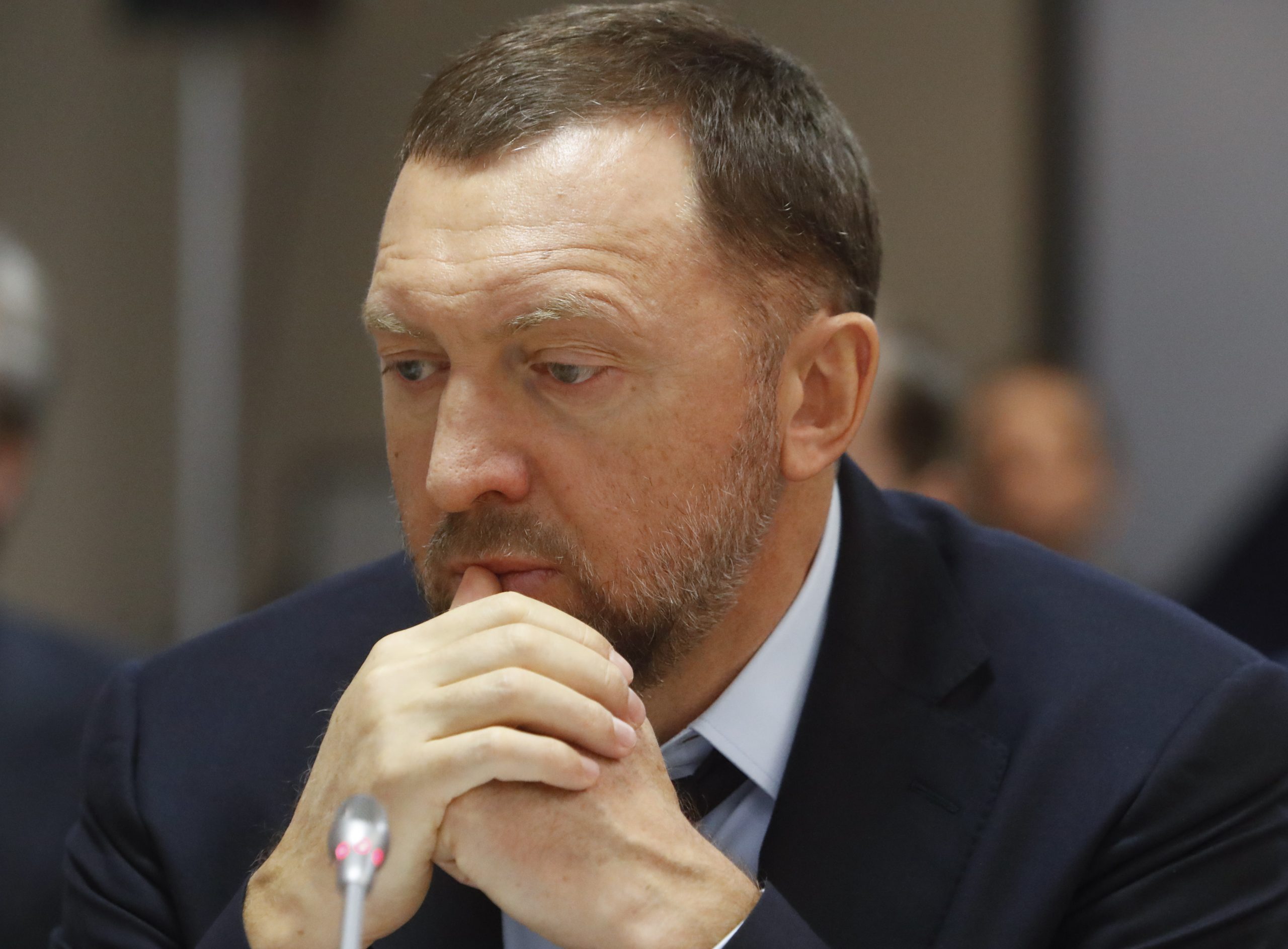
President of En+ Group, Oleg Deripaska attends an agreement signing ceremony with the Krasnoyarsk region’s government, in Moscow, Russia December 12, 2017. REUTERS/Sergei Karpukhin
A third prominent Russian businessman, to whom the Mueller report devotes twelve pages, is Kirill Dmitriev, the CEO of the state-owned Russian Direct Investment Fund, a sovereign wealth fund. Dmitriev has an outstanding professional resume and US background (Stanford, BA; Harvard, MBA; McKinsey; and Goldman Sachs), and he is Putin’s point man to the US elite. His efforts to promote Putin’s contacts with the new Trump administration included meetings with Lebanese American businessman and convicted sex offender George Nader and Blackwater founder Erik Prince.34Mueller Report, Vol. I, pp. 147-159. The Russian Direct Investment Fund is perceived as one of Putin’s slush funds. Its particular purpose is to develop relations with top US businessmen.
A fourth Russian businessman whom the Kremlin sent to seek contacts with the Trump administration was Sergey Gorkov, CEO of VEB, a Russian state-owned funding institution. VEB is another less sophisticated, but much bigger, Putin slush fund. Gorkov met with Trump’s son-in-law, Jared Kushner, in New York in December 2016 after the elections. The Mueller investigation did not identify any evidence of anything substantive to have transpired during the Gorkov-Kushner meeting.35Mueller Report, Vol. I, pp. 161-163. Soon afterward, in May 2018, Gorkov was sacked, which might indicate that he had failed in his endeavor.
The Paradise Papers, leaked financial documents that were published in November 2017, revealed offshore financial investments by top politicians and celebrities to escape paying taxes. The documents showed that two Russian billionaires, Alisher Usmanov and Yuri Milner, had invested heavily together in a row of US Internet companies early on before they had gone public. Their companies ended up owning more than 8 percent of Facebook and 5 percent of Twitter. While these initially appeared to be private investments, the Paradise Papers revealed that they were not. This was Russian state financing of US social networks—the financing had come from the Russian state bank VTB and the state company Gazprom Investholding. Furthermore, the New York Times reported: “Among Mr. Milner’s current investments is a real estate venture founded and partly owned by Jared Kushner, President Trump’s son-in-law and White House adviser.”36Jesse Drucker.“Kremlin Cash Behind Billionaire’s Twitter and Facebook Investments.” The New York Times, November 5, 2017. https://www.nytimes.com/2017/11/05/world/yuri-milner-facebook-twitter-russia.html.
The Russian military intelligence agency (GRU), the Russian security service (FSB), and the purportedly private Internet Research Agency or troll farm in St. Petersburg (closely related to the GRU) were involved in hacking and disinformation via social media in the United States during the 2016 election. Their activities in the United States were financed in part through bitcoin.37Mueller Report, Vol. I, pp. 14-50.
Quite a few big “Russian” businessmen hold US citizenship. The wealthiest is Len Blavatnik, who became a naturalized US citizen in 1984. However, he made his big money much later on in the Russian heavy industry, notably in TNK-BP, in partnership with Viktor Vekselberg, who was sanctioned by the US government as a Kremlin oligarch in April 2018. Blavatnik “contributed $3.5 million to the [US Republican Sen. Mitch] McConnell-affiliated Senate Leadership Fund between 2015 and 2017,” as well as $1 million to Trump’s inauguration, according to Washington Post columnist Dana Milbank.38Dana Milbank, “Opinion | McConnell’s New Posture toward Moscow.” The Washington Post. WP Company, August 3, 2019. https://www.washingtonpost.com/opinions/mcconnells-new-posture-toward-moscow/2019/08/02/a3b5a080-b53f-11e9-951e-de024209545d_story.html. Blavatnik is the third-biggest owner of Rusal, the Russian aluminum giant, whose biggest owner was Deripaska before US sanctions forced him to divest. The second-biggest owner is Vekselberg, and a fourth prominent owner is VTB. Rusal, Deripaska, Vekselberg, and VTB have all been sanctioned by the US government for illicit support of the Kremlin.39“Opinion | McConnell’s New Posture toward Moscow.” Blavatnik is a US citizen and cannot be sanctioned by the United States, but his funding can hardly be considered legitimate. After intense lobbying by Rusal, US sanctions against that company were lifted. Arguably, Rusal was too big to be sanctioned, but almost immediately afterward Rusal committed to investing $200 million in a company in Kentucky, McConnell’s home state. All this is both public and legal.
Around the 2016 elections, Blavatnik, who owns Warner Media, became interested in US politics. From “2015 to late 2017, he donated at least $6.35 million to Republican party institutions, PACs, and candidates… Most of that cash went to Super PACs associated with Senate majority leader Mitch McConnell and onetime presidential candidates Marco Rubio, Scott Walker, John Kasich, and Lindsey Graham.”40Max de Haldevang. “Major GOP Donor Len Blavatnik Had Business Ties to a Russian Official.” Quartz, January 22, 2019. https://qz.com/1521847/major-gop-donor-len-blavatnik-had-business-ties-to-a-russian-official/. If Blavatnik had been sanctioned as his longtime partner Vekselberg was, this would not have been legal. Now it was.
In some cases, Russian activity has been linked to serious criminal acts—in such instances there is a clear legal case to prosecute. The extreme example is the case of the leading Russian arms trader Viktor Bout, renowned as the “Merchant of Death,” who used “at least a dozen shell companies in Delaware” and “was under federal indictment for conspiracy to kill American citizens, acquire and use antiaircraft missiles and supply material to terrorists.”41Lynnley Browning, “Delaware Laws, Helpful to Arms Trafficker, to Be Scrutinized,” The New York Times, November 4, 2009. https://www.nytimes.com/2009/11/05/business/05tax.html In 2012, the United States sentenced Bout to twenty-five years in prison on terrorism charges.42“Viktor Bout Sentenced to 25 Years in Prison.” The Guardian. Guardian News and Media, April 5, 2012. https://www.theguardian.com/world/2012/apr/05/viktor-bout-sentenced-25-years-prison. Russia has persistently asked for Bout to be released to Russia.
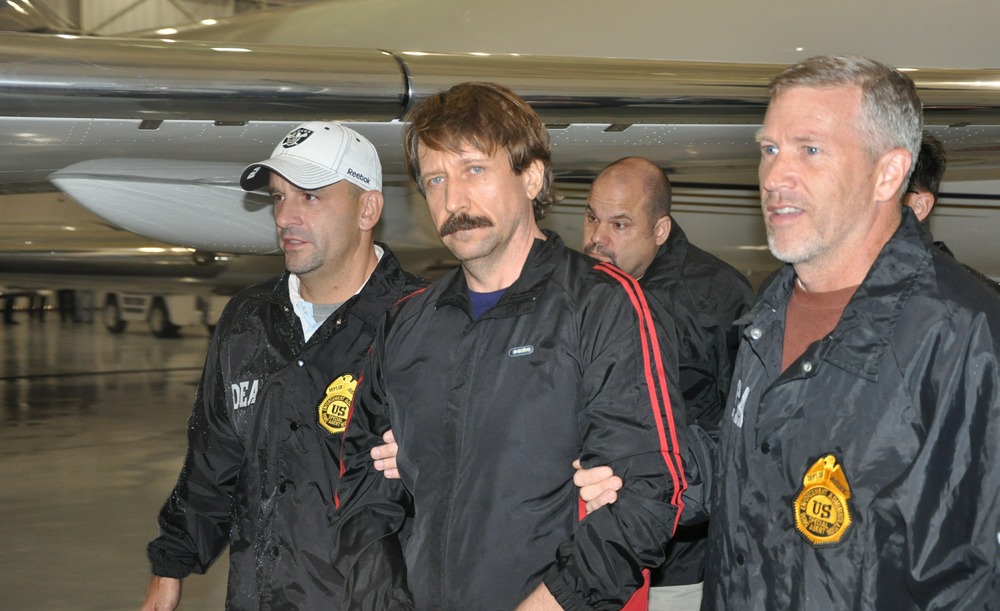
Russian arms dealer Viktor Bout being escorted by Drug Enforcement Administration agents. The 43-year-old former Soviet air force officer known as the “Merchant of Death” faced US accusations of trafficking arms since the 1990s to dictators and conflict zones in Africa, South America, and the Middle East . Credit: Drug Enforcement Administration
II. Reframing the National Security Challenge of Russian Money
Defining what constitutes “dark money” within the current AML framework and how to purge it from the US financial ecosystem is no easy task. In the wake of 9/11, the US government overhauled its AML legislation to expand its authority and break down interagency firewalls focusing on counterterrorism. But other threats have surged, such as cyberattacks, election meddling, and opaque financial influence over Washington powerbrokers. The line between domestic and foreign policy has become increasingly artificial.
A military perspective is too narrow for today’s national security challenges. The dominant power today belongs to the financial markets, where the US dollar exerts asymmetric control. Accordingly, the United States needs to broaden its perspective and realize that safeguarding the US and Western financial systems is a key matter of national security. It is as important as traditional territorial or nuclear defense. The soundness of the US banking system is not only the responsibility of prudential supervisors, it is also a fundamental national security concern. The massive loan fraud or “Russian Laundromat” that denuded Moldova’s three largest banks of more than $1 billion in 2014 and threatened to crash the financial system of that country demonstrated that Ponzi schemes must not be seen only through the lens of financial regulators. Russian actors have frequently used Moldova as a transit point and the first step to launder funds into Western financial jurisdictions.43Organized Crime and Corruption Reporting Project. “Laundromat.” OCCRP. https://www.occrp.org/en/laundromat/.
The 2017-18 scandal surrounding the Estonian branch of Danske Bank, which involved money laundering of more than $200 billion, perhaps the largest proven money laundering scandal ever uncovered, demonstrated how nonresident depositor accounts from Russia and the Baltics could serve as a conduit for the assets of Kremlin associates and then threaten the solvency of the Estonian financial system.44Lund, Michael, Simone Bendtsen, and Eva Jung. “Report: Russia Laundered Millions via Danske Bank Estonia.” OCCRP, February 26, 2018. https://www.occrp.org/en/investigations/7698-report-russia-laundered-billions-via-danske-bank-estonia.
These are but two examples of how the financial world and its mismanagement or deliberate abuse affect the security and stability of a country. Such behavior does not have the capacity to inflict anywhere close to this kind of damage to the United States due to the sheer size of its economy, but it can use the US jurisdiction as a holding zone for assets that damage others or create fissures in the US democracy.

Ilan Shor was at the center of the $1 billion bank fraud scandal in 2014 which threatened to crash the financial system of Moldova. Image: Public domain.
The US government needs to pursue a conscious strategy to shift track and target Russian actors who engage with, and illicitly exploit, the US financial system. Traditionally, the US government takes action against Russian accountholders and legal persons due to an established beneficiary of certain assets, not because of their geographic origin. For example, the United States sanctioned Yevgeniy Prigozhin because of his “attempts to subvert American democratic processes,” but not because he is Russian.45“Treasury Targets Assets of Russian Financier Who Attempted to Influence 2018 U.S. Elections | U.S. Department of the Treasury.” U.S. Department of the Treasury, October 30, 2020. https://home.treasury.gov/news/press-releases/sm787. Debt and equity restrictions imposed on oil parastatal Rosneft are not in place to punish Russia at large, but because those who designed these measures judged at the time that limiting the ability of key Russian firms to raise capital could alter the calculus of industry participants close to the center of decision making in the Kremlin.46“Announcement of Treasury Sanctions on Entities Within the Financial Services and Energy Sectors of Russia, Against Arms or Related Materiel Entities, and Those Undermining Ukraine’s Sovereignty.” U.S. Department of the Treasury, July 16, 2014. https://www.treasury.gov/press-center/press-releases/pages/jl2572.aspx. The same premise holds true for the sanctions imposed against Rusal while targeting Deripaska, who was sanctioned “for having acted or purported to act for or on behalf of, directly or indirectly, a senior official of the Government of the Russian Federation.”47“Treasury Designates Russian Oligarchs, Officials, and Entities in Response to Worldwide Malign Activity.” U.S. Department of the Treasury, April 6, 2018. https://home.treasury.gov/news/press-releases/sm0338. The US government takes specific action in response to specific behavior. This principle is considered by most practitioners to be the gold standard of sanctions policy.
The closest the current system comes to addressing corruption and ill-gotten gains explicitly is through the 2016 Global Magnitsky Human Rights Accountability Act (GloMag) and the accompanying executive order, which targets individuals who have used corrupted funds and pilfered state wealth to undemocratic or violent ends.48Committee on Foreign Relations. Bill, Global Magnitsky Human Rights Accountability Act §. S. 284 (2016). https://www.congress.gov/bill/114th-congress/senate-bill/284/text. Although these measures were designed with Russian corrupt funds in mind, they can be applied to a person of any nationality and are applied retroactively. In US government parlance, they hold malign actors “accountable.” GloMag designations intend to signal US resolve to target global corruption and to serve as a deterrent for financial criminals, but in practice they punish individuals who should be prosecuted if the rule of law worked well. When it comes to AML, US policymakers at the Treasury Department and its regulator, FinCEN, are taught to track typologies and patterns of behavior, rooted in the methodology developed by the Financial Action Task Force (FATF), an organ of the Organization for Economic Cooperation and Development (OECD), and bolstered by the analysis of the intelligence community, which has several outfits dedicated to illicit finance. These experts typically observe the prolific use of shell companies and the abuse of common law jurisdictions and their financial intermediaries to move assets with little risk of scrutiny or accessibility by the formal financial system or law enforcement.
Here we face three challenges. First, the US national security apparatus has a broad prerogative regarding illicit financial flows. But between Iran and Venezuela, Central American narcotraffickers, and financial facilitators of terrorist groups, targeting Russian money rarely takes precedence. The complex network of specialists and government agencies involved in investigating and possibly prosecuting specific individuals leads to a clear prioritization of sanctions evasion and known terrorist financiers. Furthermore, international standards require countries to have the legal authority to prosecute money laundering as a stand-alone offense, but in practice, prosecutors are likely to go after big fish whose laundering of funds is linked to other criminal behavior.
Second, despite efforts to break down barriers between the different intelligence services after 9/11, the intersection between concerns with Russian behavior and domestic problems remains limited. The Treasury works closely with regulators, such as the Securities and Exchange Commission, and with the Department of Justice, but there is little thematic overlap in their daily work. The Treasury, in collaboration with intelligence partners, will be concerned about Russian financial flows abroad, such as funding separatists in Ukraine or providing material assistance to President Bashar al-Assad’s forces in Syria. The FBI, on the other hand, will be more concerned with counterintelligence, organized crime, or fraud. In the wake of the 2016 election, an election security task force and congressional legislation mandating sanctions on election meddlers broke down some barriers conceptually, but shortcomings in institutional focus strain this cooperation. More concretely, statutory limitations (Treasury employees do not have access to an active domestic investigation, for example) make it hard to follow a targeted foreign asset through to its final destination in US jurisdiction.
Third, the conflation of tax evasion and money laundering, which are two separate offenses, is a distinction often lost on legislators. Tax evaders are almost certainly the predominant abusers in the United States of anonymous Limited Liability Companies (LLCs), foundations, trusts, shell companies, and the newest iteration—shelf companies—LLCs that are pre-established and registered with FinCEN by a third party and sold wholesale. Fending off Russian tax evasion isn’t a negative side effect of AML efforts, but our system is not designed to presume that incoming Russian funds are illicit just because they are Russian.
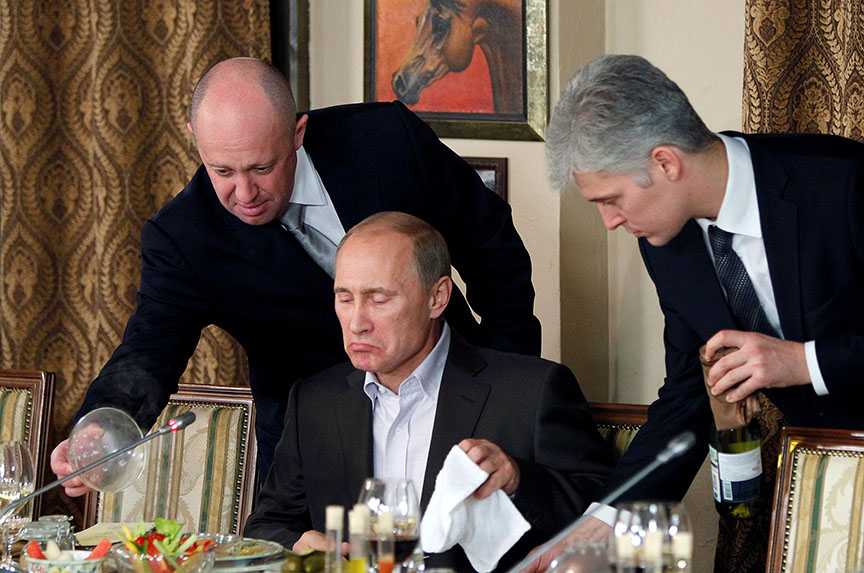
Yevgeniy Prigozhin (L) assists Russian Prime Minister Vladimir Putin during a dinner with foreign scholars and journalists at the restaurant Cheval Blanc on the premises of an equestrian complex outside Moscow November 11, 2011. The United States sanctioned Yevgeniy Prigozhin because of his “attempts to subvert American democratic processes.” REUTERS/Misha Japaridze
First stop: Europe
International financial criminality and the interconnectedness of global markets make a strong case for broadening the concept of transatlantic security from a military alliance to including a deeper financial and regulatory partnership because the United States and Europe face the same national security threat from Russian and other dark money. The world’s two largest markets need to work together on financial regulation to address these challenges, particularly given the proximity of European and US financial markets and the role of multinational financial institutions in both. The United States, the UK, and the EU each need to beef up their AML/CFT systems, as financial regulatory policy has not sufficiently bridged the gap between prudential concerns and national security.
Transatlantic partnership is also necessary due to the observed patterns of Russian behavior. Europe is typically an early stop for funds leaving Russia or the post-Soviet space, exploiting weaknesses in eurozone financial governance. The Russian funds then enter a permissive environment for business creation in the United States. These funds tend to pass through complicit pocket financial institutions in countries such as Latvia to enter the eurozone or a trust or sequence of shell companies established in Cyprus or Malta that then make deposits at a major German bank in Frankfurt, and are subsequently transferred to US jurisdiction as a German (and, therefore, less suspicious) account. The same can be said for the City of London. Other common jurisdictions are the Channel Islands and the Caribbean. In recent years, the Baltic states and Cyprus have cleaned up their act significantly. Russian funds often move directly to major European financial centers, such as the Netherlands, Luxembourg, London, and Germany.49Private information from Cypriotic bankers.
US banks and state-level regulators, who are responsible for overseeing LLCs and trusts, may submit suspicious activity reports (SARs) to FinCEN, as revealed in the “FinCEN Files,” and conduct enhanced due diligence based on how they judge the credibility of the account holder.50Will Fitzgibbon, Amy Wilson-Chapman, and Ben Hallman. “What Is the FinCEN Files Investigation?” ICIJ. International Consortium of Investigative Journalists, September 20, 2020. https://www.icij.org/investigations/fincen-files/what-is-the-fincen-files-investigation/. Such information can be matched with intelligence reporting based on overseas collection, but given the sheer size of anonymized business creation in the United States and the vast volume of assets entering the United States from European jurisdictions, the task is overwhelming. A case would have to stand out by bearing the mark of a sanctioned individual or a jurisdiction under intense US scrutiny (such as Iran, North Korea, or, increasingly, Venezuela) to warrant a follow-up.
So how can the United States and its partners stop Western jurisdictions from serving as havens for illicit wealth, especially from Russia, which appears to be the most urgent threat? For the sake of its own domestic interests but also foreign policy concerns in the European neighborhood, such as Ukraine and Belarus, the United States should throw its weight behind current EU efforts to overhaul its AML/CFT framework, which is a massive undertaking that has received little public attention. Nineteen countries in the eurozone have a common currency governed by strong prudential rules, many of which were introduced during the eurozone crisis. However, in the wake of the Danske Bank money laundering scandal, Brussels regulators realized that their framework to combat financial criminality across the bloc remained ruinously weak. By and large, it leaves the control of money laundering to national agencies, and European economies are quite heterogeneous and their financial sectors diverse. The capacity (or willingness) of individual governments to marshal financial, law enforcement, and judicial authorities varies as well. As a consequence, the eurozone has become a ripe environment for financial abuse. Russian oligarchs have skillfully exploited the weaknesses of the eurozone’s financial controls to access high-end real estate markets and private educational opportunities.
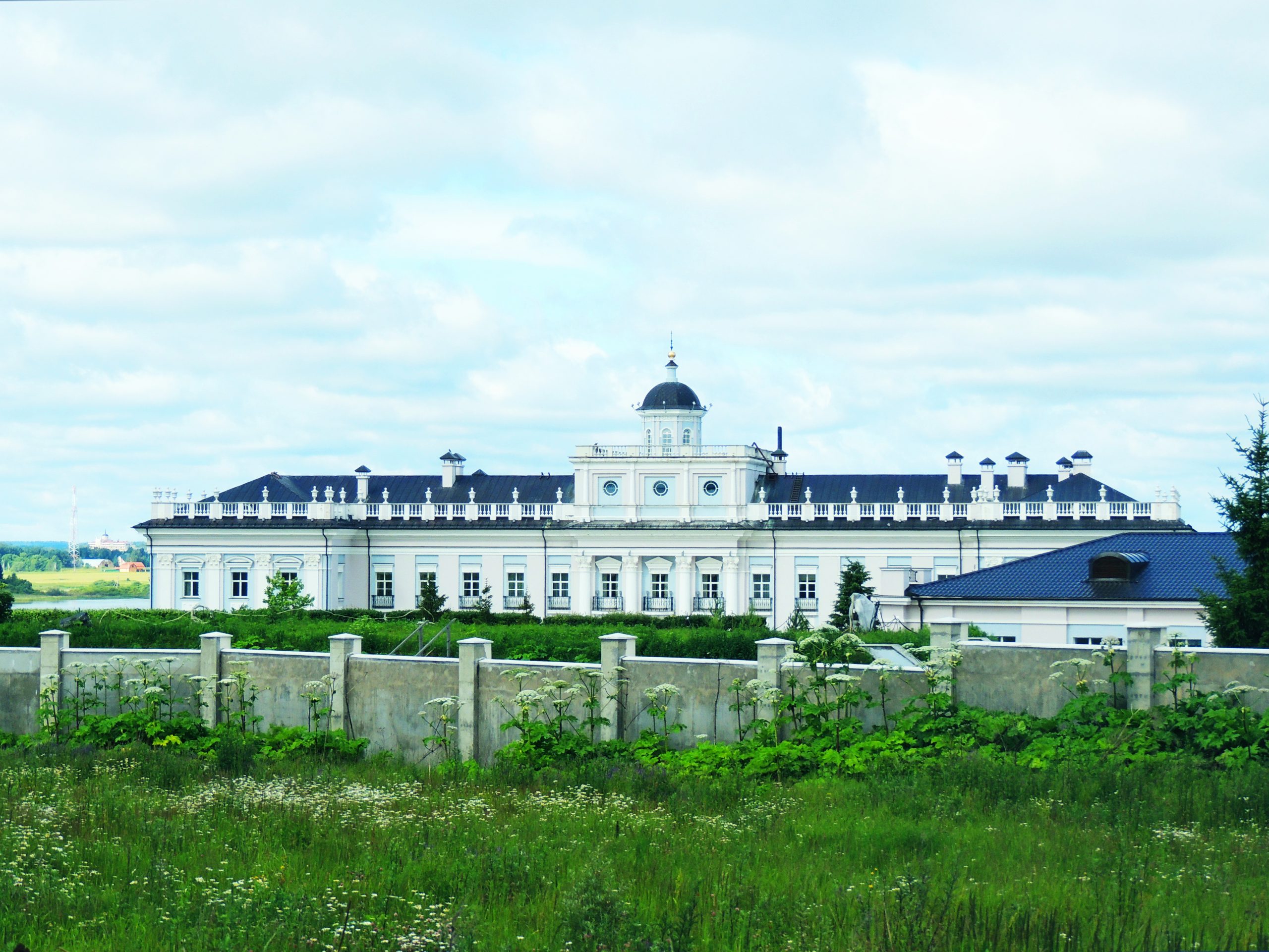
A view of the Residence on the Istra Reservoir, also known as Millerhof, supposedly owned by Gazprom CEO Alexei Miller. Wikimedia. Credit: Wikimedia
This spring, European institutions greenlighted a plan by the European Commission to overhaul how the EU approaches AML/CFT. The first step will be to ensure implementation of the 5th Anti-Money Laundering Directive, which was adopted in June 2018. It is a robust set of policy guidelines that all member states are compelled to adopt this year. It enshrines public access to beneficial ownership information by requiring all enterprises and entities in the twenty-seven members of the EU and the European Economic Area (Iceland, Liechtenstein, Norway, and Switzerland) to establish public registries of their ultimate beneficiary owners.51European Commission, Directive (EU) 2018/843 of the European Parliament and of the Council of 30 May 2018 amending Directive (EU) 2015/849 on the prevention of the use of the financial system for the purposes of money laundering or terrorist financing, and amending Directives 2009/138/EC and 2013/36/EU, May 30, 2018. https://eur-lex.europa.eu/legal-content/EN/TXT/?uri=CELEX%3A32018L0843
The second major component of this EU plan is to establish a mechanism for better information sharing between financial intelligence units (FIUs, FinCEN equivalents). This crucial component of the AML/CFT framework is often poorly incorporated into government operations and operates with a small budget and staff. In the EU, some FIUs are part of the financial regulator, some are law enforcement, and some sit within finance ministries. This mixture hinders cooperation and information sharing between member state authorities, which is a fatal impediment for AML measures within a currency union and single economic market with seamless and instantaneous movement of capital between jurisdictions. In order to keep up with today’s instant international movement of vast flows of money, this reporting should ideally be automatic in the whole EU.
The third and perhaps most important part of the EU’s plan is to establish an EU-level regulatory body to oversee and enforce the activities of national competent authorities. Joshua Kirschenbaum and Nicolas Véron demonstrated the importance of European-level financial sector supervision in a report for the Peterson Institute for International Economics in January.52Joshua Kirschenbaum and Nicolas Véron, “A European anti–money laundering supervisor: From vision to legislation, Peterson Institute for International Economics,” January 23, 2020. https://www.piie.com/blogs/realtime-economic-issues-watch/european-anti-money-laundering-supervisor-vision-legislation EU architects of the plan compare this new institution to the creation of the Single Supervisory Mechanism (SSM) for prudential oversight in the wake of the eurozone crisis. The European Central Bank established the SSM to stabilize the European banking sector, but it has only very limited power to monitor Europe’s systemic banks for illicit financial risk.
Finally, a fundamental problem with European banking regulation is that, unlike in the United States, fines for violations have been tiny. High US fines have compelled US-based banks to start taking compliance more seriously. A European AML agency should be allowed to levy large fines to persuade European banks to build up a strong compliance culture as US banks have done. European regulators are keenly aware that cohesive AML/CFT controls are one of several important steps to increase the global role of the European common currency.
Tackling the inflow of ill-gotten Russian funds into the EU is a great challenge: some member states will resist such an effort in order to protect their own equities and some will implement the policy poorly, but the European plan is a major step in the right direction. The United States should show its full technical and political support for these efforts to complement the pressure it has placed on the bloc to take a more aggressive sanctions posture toward Russia, such as establishing a parallel Magnitsky authority. The EU’s plan will serve as a first-line defense for the United States
Policy recommendations for the United States
Defense against Russian dark money will require a shift in US regulatory culture. The aim should be to corral the power and resources of the intelligence agencies, regulators, and the judiciary to view incoming Russian funds as inherently suspicious rather than targeting offenders based on specific patterns of behavior or a predicate offense. This would require a clear mandate in the executive branch akin to the counterterrorism infrastructure that developed after 9/11. Russian financing (and more broadly speaking, illicit finance) would climb up the priority ladder of the National Intelligence Priorities Framework, which helps rank national security concerns in order of importance.
The United States does not need a “maximum pressure campaign,” which has proven to be foolhardy when applied against kleptocratic petrostates such as Iran and Venezuela. As global sanctions pressure has increased on Venezuela, an ironic import substitution has taken place: US purchases of Russian crude oil nearly doubled from 2018 and 2019 and have continued to rise even during the glut market during the COVID-19 crisis.53“Russia Continues Raising Fuel Oil Exports to United States.” Reuters. August 6, 2020. https://www.reuters.com/article/us-russia-usa-fueloil/russia-continues-raising-fuel-oil-exports-to-united-states-idUSKCN25228P. US venture capital and investment firms are still active in Russia as the Russian market is relatively stable in comparison to other developing markets. The unsuccessful US sanctioning of Rusal shows that not only Russia as a whole but also its biggest companies are too integrated with the global economy to be easily sanctioned. For these reasons, this report does not consider “nuclear options” such as removing Russia from the SWIFT messaging system or a “jurisdictional 311” (a reference to Section 311 of the USA PATRIOT Act) that would deny all Russian financial institutions US dollar correspondent relationships in New York. Instead, we are recommending the following actions to create a stronger and more effective US AML/CFT strategy that is designed to address the specific risks of Russian illicit financing.
Reveal ultimate beneficial ownership
The greatest handicap for the United States, as recognized by the Treasury’s 2018 Money Laundering Risk Assessment,54Rep. National Strategy for Combating Terrorist and Other Illicit Financing. 2018. https://home.treasury.gov/system/files/136/nationalstrategyforcombatingterroristandotherillicitfinancing.pdf. is the lack of a beneficial ownership requirement for financial institutions and financial service providers. As the United States argued when it was reviewed by the FATF in 2016,55FATF (2016), Anti-money laundering and counter-terrorist financing measures – United States, Fourth Round Mutual Evaluation Report, FATF, Paris www.fatf-gafi.org/publications/mutualevaluations/documents/mer-united-states-2016.html there are ways of filling these gaps, but these are cumbersome, involve different work-arounds depending on the entity in question, and often require the use of intelligence information that can only be processed in a classified setting. Given the regulatory patchwork between federal and state authorities, the United States needs national legislation (vice regulation) to impose a single, streamlined requirement. After decades of deliberation, the prohibition of anonymous companies now stands as a top item on the legislative agenda. In October 2019, the US House of Representatives adopted the Corporate Transparency Act of 2019 with a large bipartisan majority of 249-173.56“Historic Bipartisan Bill to End Anonymous Companies Passes U.S. House of Representatives.” Global Witness, October 22, 2019. https://www.globalwitness.org/en/press-releases/historic-bipartisan-bill-end-anonymous-companies-passes-us-house-representatives/. It would require all companies to register their ultimate beneficiary owners with FinCEN and make the information available to law enforcement agencies.57H.R. 2513: Corporate Transparency Act of 2019, Passed on October 22, 2019. https://www.govtrack.us/congress/bills/116/hr2513 A similar bipartisan bill, the Illicit Cash Act, is currently being considered by the Senate Banking Committee; a version of either has a chance of being adopted as part of this year’s omnibus National Defense Authorization Act.58S. 2563: ILLICIT CASH Act, Introduced September 26, 2019. https://www.govtrack.us/congress/bills/116/s2563 Imposing such a requirement would greatly strengthen US financial transparency and security. Conversely, failure to pass such crucial legislation at this juncture would underscore the relative power of lobbying organizations over transparency in Congress.
Reinforce FinCEN
FinCEN regularly issues formal guidance notifications when it identifies a new or emerging money laundering threat to the US financial system. For example, it has issued such documents recently to cover sanctions violations through shipping intermediaries and the abuse of cryptocurrencies. So far, the organization has not unpacked the specific risks posed by incoming Russian funds based on Russia as the ultimate origin of a given asset or demonstrated how these funds tend to move. Such guidance could include a step-by-step schematic of how opaque Russian financial entities can acquire real estate or participate in the fine art market. A comprehensive approach toward unpacking Russian patterns of behavior in the United States, and Europe, more broadly, would assist financial institutions and service providers in identifying suspect funds. It would also signal, as previously issued guidance has traditionally done, that these patterns of behavior are now subject to stronger enforcement. FinCEN guidance often precedes or accompanies an OFAC designation or a prosecution by the Department of Justice.
Improve financial reporting
At present, banks are required to submit SARs to FinCEN for amounts as small as $10,000 within one month. As a consequence, FinCEN is flooded with information of innocuous, small, and irrelevant transactions that arrive far too late. The reporting needs to become much faster and should preferably be automatic, while it should concentrate on truly suspicious transactions.
Broaden the USA PATRIOT Act to cover all relevant institutions
The 2001 landmark legislation granted law enforcement and intelligence agencies broad authorities to track and counter terrorism-related activities. In the financial realm, these measures focused on the role that New York plays in facilitating global dollar-based commerce and turned the dollar itself into an AML enforcement mechanism. US financial institutions were barred from transacting with shell banks overseas and required to conduct due diligence on all correspondent accounts for foreign financial institutions.59“USA PATRIOT Act.” Financial Crimes Enforcement Network. U.S. Treasury. https://www.fincen.gov/resources/statutes-regulations/usa-patriot-act. The USA PATRIOT Act has proven its effectiveness by leading to a closing down of shell banks throughout the world. It needs to be applied to a wider range of asset holders and intermediaries.
The United States should strongly consider expanding the list of obliged entities under the Banking Secrecy Act to compel lawyers, accountants, real estate brokers, and fine art dealers to submit SARs to FinCEN and thus avoid the abuse of client-attorney privilege to evade regulatory scrutiny as well as the cumbersome relationship between state and federal regulators. The good news is regulatory amendments are underway. The recent ANPRM on Anti-Money Laundering Program Effectiveness60“Anti-Money Laundering Program Effectiveness.” Federal Register, September 17, 2020. https://www.federalregister.gov/documents/2020/09/17/2020-20527/anti-money-laundering-program-effectiveness. and final ruling on non-federally supervised banking institutions or the “Gap Rule”61“Financial Crimes Enforcement Network; Customer Identification Programs, Anti-Money Laundering Programs, and Beneficial Ownership Requirements for Banks Lacking a Federal Functional Regulator.” address these shortcomings.
Aside from reporting requirements, the most well-known provision is Section 311 of the USA PATRIOT Act, an authority that allows FinCEN to deny a foreign financial institution access to US correspondent markets by identifying it as an “institution of primary money laundering concern.” Section 311 actions have a mixed track record due to the prudential effects of preventing US dollar transactions, especially in small jurisdictions with niche financial sectors and few dollar reserves. When well-calibrated, 311s have been quite successful in triggering comprehensive AML/CFT reforms in a country, particularly in Europe where Russian actors are likely to transact. The 2018 311 action against ABLV Bank in Latvia,62“FinCEN Names ABLV Bank of Latvia an Institution of Primary Money Laundering Concern and Proposes Section 311 Special Measure.” Financial Crimes Enforcement Network, 2018. https://www.fincen.gov/news/news-releases/fincen-names-ablv-bank-latvia-institution-primary-money-laundering-concern-and. for example, was part of a years-long campaign by the US Treasury to clear up a niche banking sector that catered to nonresident clientele from Russia and former Soviet Union countries and provided a clear path for illicit Russian financial actors to move assets into the eurozone and beyond. However, because 311s are regulatory actions that require lengthy comment periods and a notice of proposed rulemaking, it takes—optimistically speaking—six months from start to finish. By the time the action is finalized, most of the illicit assets are long gone and the institution itself is preparing to wind down. Small linguistic tweaks to the USA PATRIOT Act can make a 311 an administrative vice regulatory action and allow for the Treasury to impose restrictions within weeks. A further small, but meaningful change to the USA PATRIOT Act would allow Treasury to target not only banks but non-bank financial service providers, insofar as they maintain access to US markets, since the risk profile of these institutions has grown significantly since 2001. Future congressional legislation focused on Russia should propose these changes instead of broad-brush measures that could force banks to use other large reserve holders, such as China, to complete international payments.
Restrict access to investment vehicles
The last provision of the USA PATRIOT Act worth mentioning in the Russian context is Section 356, which imposes a SAR filing requirement for brokers and dealers. To date, there has been little work done in the public sector to monitor the activity of Russian firms and individuals in US private equity and securities markets, largely due to privacy obligations between brokers and their clients. Russian participants are likely to be high-net-worth individuals with broad international connections and employ a network of financial intermediaries. The Securities and Exchange Commission should expand this provision of the USA PATRIOT Act and require financial service providers to submit a regular report profiling their known Russian client base to assist the regulator in establishing Russian patterns of behavior. As Congress and the administration consider restricting market access for Chinese firms that do not uphold US accounting requirements, a similar approach could be taken with regard to Russia. Although restrictions on market participation cannot be developed overnight, greater clarity on the role that private equity and securities markets play in Russian wealth management and/or diversion of assets into Western jurisdictions will be instructive to build stronger money laundering typologies. The United States can also hold this concept in its back pocket should restrictions to access to New York markets become justified.
Geographic target orders for real estate have proven useful
In 2016, FinCEN established “geographic target orders” (GTOs), requiring “U.S. title insurance companies to identify the natural persons behind shell companies used to pay for high-end residential real estate in seven metropolitan areas,” including Miami-Dade and Broward Counties and Palm Beach in Florida, New York, and Los Angeles. These checks focus on cash and wire transfer payments to monitor for high-net-worth individuals who pay for properties outright.63Financial Crimes Enforcement Network (FinCEN). FinCEN Targets Shell Companies Purchasing Luxury Properties in Seven Major Metropolitan Areas, US Treasury, August 22, 2017; Nicholas Nehamas and Rene Rodriguez, Feds Widen Hunt for Dirty Money in Miami Real Estate, Miami Herald, August 23, 2017. If beneficial ownership legislation is passed, the need for GTOs to serve as a work-around for regulators will decrease and allow for more flexible applications of the tool. GTOs could be applied to determine the payment structure of Russian clients and help develop restrictions on the real estate market, such as a ban on cash purchases by legal persons with no established commercial presence in the United States.
Civil forfeiture is a useful tool
In 2018, the UK introduced a new legal tool, the Unexplained Wealth Order, which allows authorities to claim property in a civil recovery process if the legal authorities can prove that the wealth was not honestly earned.64Rachel Davies Teka. “Unexplained Wealth Orders: A Brief Guide.” Transparency International UK. https://www.transparency.org.uk/unexplained-wealth-orders-brief-guide. Like with GTOs, a version of the Unexplained Wealth Order could be used in the United States to target large foreign funds and investments or real estate holdings associated with money laundering or sanctions cases. In some respects, the building blocks are already in place. Domestic regulators can use Section 314a of the USA PATRIOT Act to compel financial institutions to submit additional information on a suspicious client or set of transactions.65Financial Crimes Enforcement Network, FinCEN’s 314(a) Fact Sheet § (2020). U.S. Treasury. https://www.fincen.gov/sites/default/files/shared/314afactsheet.pdf. The Treasury manages an Executive Office of Asset Forfeiture, but this is used to manage assets seized in Customs and Border Protection or Internal Revenue Service procedures.
The Department of Justice does issue indictments over large claims when it encounters violations of US sanctions or large-scale money laundering abroad, based on the global use of the dollar—the cases against Halkbank66“Turkish Bank Charged in Manhattan Federal Court for Its Participation in a Multibillion-Dollar Iranian Sanctions Evasion Scheme.” The United States Department of Justice. Office of Public Affairs, October 15, 2019. https://www.justice.gov/opa/pr/turkish-bank-charged-manhattan-federal-court-its-participation-multibillion-dollar-iranian. or Iranian oil tankers en route to Venezuela,67“Largest U.S. Seizure of Iranian Fuel from Four Tankers.” The United States Department of Justice. Office of Public Affairs, August 14, 2020. https://www.justice.gov/opa/pr/largest-us-seizure-iranian-fuel-four-tankers. for example—but it has yet to use this considerable power to prosecute and confiscate assets domestically. Civil forfeiture is used for domestic US cases but in limited capacity to seize typically small-scale assets of indebted individuals or proceeds of domestic crime. This is a question of setting priorities. Iranian sanctions violations have taken national security precedence and show that the system can work effectively when directed to do so. However, this posture reflects an institutional bias to treat illicit financial activity as an overseas target and not a domestic threat in need of enforcement. It also indicates a reluctance to acknowledge the sheer scope of the domestic problem and the concentration of effort it would take to address it, including any implications for large US banks. This is not to say that US investigators need to concentrate all their efforts in cleaning house. In the end, the seizure of several Park Avenue apartments would send a strong signal
Reverse burden of proof for unexplained wealth
Given the opacity of payment structures and abuse of legal instruments and intermediaries, reaching a legal determination on suspected financial support for cyber intrusion, illicit support for political organizations, or election meddling, the United States could consider applying a reverse burden of proof standard—put simply, proving innocence rather than guilt in line with the UK legislation on Unexplained Wealth Orders. This standard could apply, for example, to cases against crypto troll farms and the purchase of cyber infrastructure and IP addresses used to create disinformation on US social media platforms, as outlined in the Mueller indictments and discussed earlier in this paper.
Conclusion
This report assumes that the United States can make significant, but not sweeping, changes quickly if it chooses to set new priorities to tackle illicit finance, and offers suggestions on how to aid this process. Beneficial ownership legislation still faces strong opposition, demonstrating, perhaps, that the United States still has great capacity to be its own worst enemy. US financial regulatory policy is a patchwork of federal, state, and local authorities that is hard to dissect, even for practitioners sitting in the middle of it, but no one is going back to tabula rasa. It is foolhardy to imagine sweeping restrictions on easy business creation and LLCs, as some have suggested, because such practices are part of what make the US economy flexible and friendly to innovation, small business growth, and international investment. Lastly, reporting requirements cannot be overly burdensome for small businesses because incomplete or cursory information doesn’t help the authorities or the larger financial institutions asking for it in the first place.
The risk of Russian illicit finance is one example how foreign threats have become domestic, or at least how the false distinction between domestic and foreign policy can become dangerous, especially within a complicated and often permissive legal framework and a global financial system upheld by multinational banks whose purpose is to dismantle—not create—barriers to international commerce. Russia is the starkest case because of its impact on our national dialogue and confidence in our institutions. By creating confusion and political discord, and exposing the US underbelly to corruption, Russia has succeeded in provoking the United States to use its own weaknesses against itself—a hybrid threat if there ever was one.
About the authors
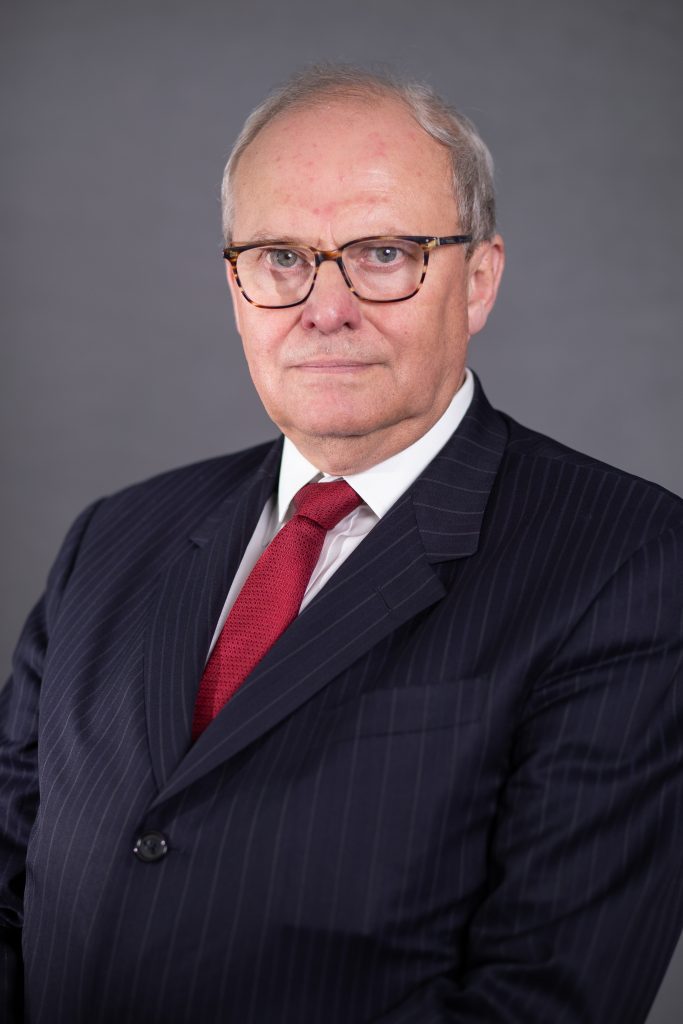
Dr. Anders Åslund
Senior Fellow, Eurasia Center
Anders Åslund is a resident senior fellow in the Eurasia Center at the Atlantic Council. He also teaches at Georgetown University. He is a leading specialist on economic policy in Russia, Ukraine, and East Europe.
Dr. Åslund has served as an economic adviser to several governments, notably the governments of Russia (1991-94) and Ukraine (1994-97). He is chairman of the Advisory Council of the Center for Social and Economic Research, Warsaw, and of the Scientific Council of the Bank of Finland Institute for Economies in Transition. He has published widely and is the author of fourteen books, most recently Russia’s Crony Capitalism: The Path from Market Economy to Kleptocracy (YUP, 2019) and with Simeon Djankov, Europe’s Growth Challenge (OUP, 2017) and Ukraine: What Went Wrong and How to Fix It (2015). Other books of his are How Capitalism Was Built (CUP, 2013) and Russia’s Capitalist Revolution (2007). He has also edited sixteen books.

Julia Friedlander
C. Boyden Gray Senior Fellow and Deputy Director, GeoEconomics Center
Julia Friedlander is the C. Boyden Gray Senior Fellow and Deputy Director of the GeoEconomics Center.
Ms. Friedlander served as Senior Policy Advisor for Europe in the Office of Terrorism and Financial Intelligence at the U.S. Department of the Treasury from 2015-2017 and from 2019-20, where she collaborated with EU partners on global sanctions policy and combatting illicit finance. She also served as a macroeconomist in the Europe Office in Treasury’s Department of International Affairs.
From April 2017 to July 2019, Julia was detailed to the White House as the Director for the European Union, Southern Europe and Economic Affairs at the National Security Council, charged with coordinating U.S. interagency policy on transatlantic relations and the European Union and staffing the national security advisor on European engagements. Her work encompassed all aspects of security and economic relations, but focused on trade, financial policy, and investment security.
About the programs

The Eurasia Center’s mission is to enhance transatlantic cooperation in promoting stability, democratic values and prosperity in Eurasia, from Eastern Europe and Turkey in the West to the Caucasus, Russia and Central Asia in the East.
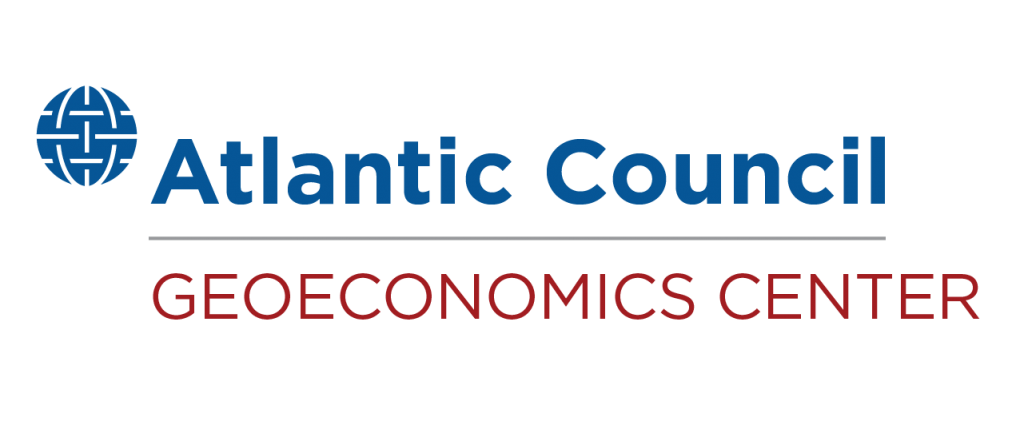
At the intersection of economics, finance, and foreign policy, the GeoEconomics Center is a translation hub with the goal of helping shape a better global economic future.
